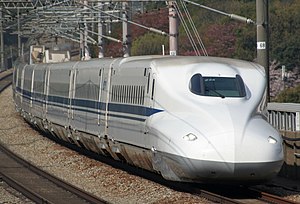N700 Series Shinkansen
| N700 series | |
|---|---|

JR Central N700 series set Z28 on the Sanyo Shinkansen in April 2009
|
|
| In service | 2007–Present |
| Manufacturer | Hitachi, Kawasaki Heavy Industries, Kinki Sharyo, Nippon Sharyo |
| Replaced | 300 series, 500 series, 700 series |
| Constructed | 2005– |
| Number in service | 2,304 vehicles (159 sets) (as of 30 June 2016[update]) |
| Number scrapped | 1 vehicle (fire damage) |
| Formation | 16 cars per trainset (8 cars per trainset for N700-7000/8000) |
| Capacity | Tokaido/Sanyo 16-car sets (F, G, K, N, X, Z): 1,323 (200 Green + 1,123 ordinary) Sanyo/Kyushu 8-car sets (R, S): 546 (24 Green + 522 ordinary) |
| Operator(s) |
|
| Depot(s) | Tokyo, Hakata, Osaka, Kumamoto |
| Line(s) served | Kyushu Shinkansen, Tokaido Shinkansen, Sanyo Shinkansen, Hakata-Minami Line |
| Specifications | |
| Car body construction | Aluminium |
| Car length | 25,000 mm (82 ft 0 in) (intermediate cars) 27,350 mm (89 ft 9 in) (end cars) |
| Width | 3,360 mm (11 ft 0 in) |
| Height | 3,600 mm (11 ft 10 in), 3,500 mm (11 ft 6 in) (end cars) |
| Maximum speed | 285 km/h (177 mph) (Tokaido) 300 km/h (186 mph) (Sanyo) 260 km/h (162 mph) (Kyushu) |
| Weight | 715 t (16-car set) |
| Traction system | 56 x 305 kW (409 hp) |
| Power output | 17.08 MW (22,900 hp) |
| Acceleration | 2.6 km/h/s |
| Electric system(s) | 25 kV AC, 60 Hz overhead catenary |
| Current collection method | Pantograph |
| UIC classification | 2'2'+14*Bo'Bo'+2'2' (N, Z and G sets) 8*Bo'Bo' (R and S sets) |
| Braking system(s) | Pneumatic, regenerative |
| Safety system(s) | ATC-1, ATC-NS, KS-ATC (R and S sets only) |
| Track gauge | 1,435 mm (4 ft 8 1⁄2 in) |
The N700 series (N700系 Enu nanahyaku-kei?) is a Japanese Shinkansen high-speed train with tilting capability developed jointly by JR Central and JR-West for use on the Tokaido and Sanyo Shinkansen lines since 2007, and also operated by JR Kyushu on the Kyushu Shinkansen line.
N700 series trains have a maximum speed of 300 km/h (186 mph), and tilting of up to one degree allows the trains to maintain 270 km/h (168 mph) even on 2,500 m (8,200 ft) radius curves that previously had a maximum speed of 255 km/h (158 mph). Another feature of the N700 is that it accelerates quicker than other shinkansen trains, with a maximum acceleration rate of 2.6 km/h/s. This enables it to reach 270 km/h (170 mph) in only three minutes. Because of these improvements, trains can travel between Tokyo and Osaka on a Nozomi run in as little as 2 hours and 22 minutes on a fastest service. (8 minutes faster than before).
N700 series trains gradually replaced 300, 500 and 700 series sets on Nozomi services, and by the end of February 2009, the N700 series were responsible for 74 Nozomi services per day. All Nozomi through runs (over the full route between Tokyo and Hakata) were scheduled to use the N700 series exclusively by 2009. By 2011, all regularly scheduled Nozomi services, including runs limited only to the Tokaido Shinkansen, were operated by the N700 series.
The N700 is also used on select Hikari services during the day, as well as some early-morning and late-night Kodama runs between Tokyo and Mishima/Hamamatsu.
...
Wikipedia
